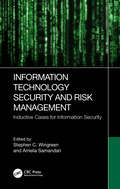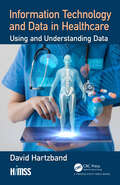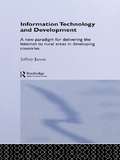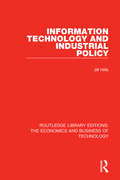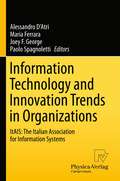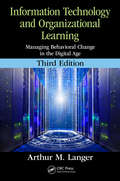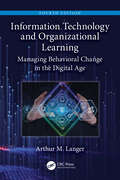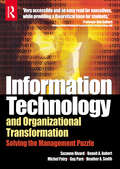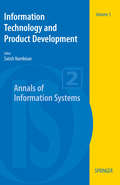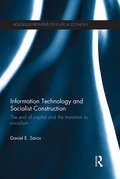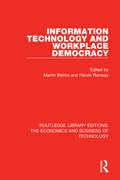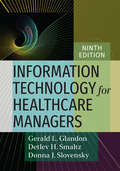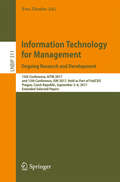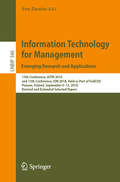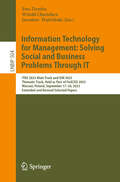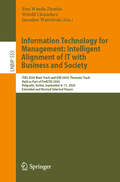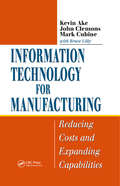- Table View
- List View
Information Technology Security and Risk Management: Inductive Cases for Information Security
by Stephen C. Wingreen Amelia SamandariInformation Technology Security and Risk Management: Inductive Cases for Information Security is a compilation of cases that examine recent developments and issues that are relevant to IT security managers, risk assessment and management, and the broader topic of IT security in the 21st century. As the title indicates, the cases are written and analyzed inductively, which is to say that the authors allowed the cases to speak for themselves, and lead where they would, rather than approach the cases with presuppositions or assumptions regarding what the case should be "about". In other words, the authors were given broad discretion to interpret a case in the most interesting and relevant manner possible; any given case may be "about" many things, depending on the perspective adopted by the reader, and many different lessons may be learned. The inductive approach of these cases reflects the design philosophy of the advanced IT Security and Risk Management course we teach on the topic here at the University of Canterbury, where all discussions begin with the analysis of a specific case of interest and follow the most interesting and salient aspects of the case in evidence. In our course, the presentation, analysis, and discussion of a case are followed by a brief lecture to address the conceptual, theoretical, and scholarly dimensions arising from the case. The inductive approach to teaching and learning also comes with a huge advantage – the students seem to love it, and often express their appreciation for a fresh and engaging approach to learning the sometimes-highly-technical content of an IT security course. As instructors, we are also grateful for the break in the typical scripted "chalk-and-talk" of a university lecture afforded by the spontaneity of the inductive approach.We were motivated to prepare this text because there seems to be no other book of cases dedicated to the topic of IT security and risk management, and because of our own success and satisfaction with inductive teaching and learning. We believe this book would be useful either for an inductive, case-based course like our own or as a body of cases to be discussed in a more traditional course with a deductive approach. There are abstracts and keywords for each case, which would help instructors select cases for discussions on specific topics, and PowerPoint slides are available as a guide for discussion about a given case.
Information Technology System That Couldn't Deliver (HBR Case Study and Commentary)
by John King Thornton May Robert A. Distefano James K. Sims Richard Nolan Byron ReimusDiana Sullivan, CEO of Lenox Insurance, thought she had done her job when, after three years of hard work, she had delivered Lifexpress on time and on budget. A sophisticated computer-aided system, it enabled Lenox's 10,000-plus agents to do everything from establish a prospect's financial profile, to select the most appropriate products from the company's myriad policies, to generate all the paperwork needed to close a sale. But now Sullivan's boss, CFO Clay Fontana, seemed to be holding her accountable not only for the creation and implementation of the system but for realizing its business goals as well. And Lenox's CEO, James Bennett, appeared to concur. In this hypothetical case study, Sullivan and the other top executives at Lenox must decide who should be responsible for realizing the business goals of information technology projects. Should Sullivan have gone about the project in another way? Should Fontana and Bennett be playing more active roles? In 97308 and 97308Z, commentators James K. Sims, Thornton May, Richard Nolan, Robert A. Distefano, and John King offer advice on this fictional case study.
Information Technology and Clinical Operations at Beth Israel Deaconess Medical Center
by F. Warren Mcfarlan Richard BohmerDescribes the history of clinical computing at Boston's Beth Israel Hospital and the development, since the 1996 merger to form the Beth Israel Deaconess Medical Center, of an information system designed to support the delivery of patient care. The hospitals' CIO, John Halamka, MD, has overseen the development of an information system that places physicians at its center. Describes the design and function of five major components of the system: the On-Line Medical Record, ePrescribing, Physician Order Entry, the Emergency Department "dashboard," and the Performance Manager. Provides students with an opportunity to identify key design principles for health care information systems, and to discuss the unique implementation challenges that the health care delivery setting raises for CIOs and CEOs.
Information Technology and Competitive Advantage in Small Firms (Routledge Studies In Small Business Ser. #Vol. 13)
by Brian Webb Frank SchlemmerDoes Information Technology matter? This book argues that even as Information Technology hardware, software, data and associated processes are becoming more of a commodity, it has never been more important to manage Information Technology as a strategic asset. However, managing Information Technology as a strategic asset is notoriously difficult, a
Information Technology and Data in Healthcare: Using and Understanding Data (HIMSS Book Series)
by David HartzbandHealthcare transformation requires us to continually look at new and better ways to manage insights – both within and outside the organization. Increasingly, the ability to glean and operationalize new insights efficiently as a byproduct of an organization’s day-to-day operations is becoming vital for hospitals and health systems to survive and prosper. One of the long-standing challenges in healthcare informatics has been the ability to deal with the sheer variety and volume of disparate healthcare data and the increasing need to derive veracity and value out of it. This book addresses several topics important to the understanding and use of data in healthcare. First, it provides a formal explanation based on epistemology (theory of knowledge) of what data actually is, what we can know about it, and how we can reason with it. The culture of data is also covered and where it fits into healthcare. Then, data quality is addressed, with a historical appreciation, as well as new concepts and insights derived from the author’s 35 years of experience in technology. The author provides a description of what healthcare data analysis is and how it is changing in the era of abundant data. Just as important is the topic of infrastructure and how it provides capability for data use. The book also describes how healthcare information infrastructure needs to change in order to meet current and future needs. The topics of artificial intelligence (AI) and machine learning in healthcare are also addressed. The author concludes with thoughts on the evolution of the role and use of data and information going into the future.
Information Technology and Development: A New Paradigm for Delivering the Internet to Rural Areas in Developing Countries (Routledge Studies In Development Economics Ser. #Vol. 39)
by Jeffrey JamesAttempts to bring the benefits of information technology in the form of the internet to developing countries have, to date, foundered on the belief that this requires the beneficiaries to access the technology directly. As a result, the perceived huge benefits of such an enterprise have often failed to materialise.This original contribution to the
Information Technology and Industrial Policy (Routledge Library Editions: The Economics and Business of Technology #20)
by Jill HillsPublished in 1984, this book reviews British industrial policy towards information technology within the context of the international trading system. It argues that the incoherence of British policy stems from the clash between its core liberal ideology and its centralised political system and that unless Britiain's traditional liberal ideology in trade policy was abandoned within this market, Britiain was set to become a mere technological dependency of America. It discusses how the British government needed to develop effective non-tariff barriers in the form of 'industrial policy' to minimise the political and economic costs of technological dependence.
Information Technology and Innovation Trends in Organizations
by Paolo Spagnoletti Joey F. George Maria Ferrara Alessandro D'AtriThe book examines a wide range of issues that characterize the current IT based innovation trends in organisations. It contains a collection of research papers focusing on themes of growing interest in the field of Information System, Organization Studies, and Management. The book offers a multi-disciplinary view on Information Systems aiming to disseminate academic knowledge. It might be particularly relevant to IT practitioners such as information systems managers, business managers and IT consultants. The volume is divided into XIV sections, each one focusing on a specific theme. A preface written by Joey George, president of the Association for Information Systems opens the text. The content of each section is based on a selection of the best papers (original double blind peer reviewed contributions) presented at the annual conference of the Italian chapter of AIS, which has been held in Naples, Italy, on October 2010.
Information Technology and Innovation at Shinsei Bank
by David M. Upton Virginia A. FullerShinsei Bank was rebuilt from the ashes of a failed predecessor, and pioneered new levels of customer service in retail banking in Japan. The bank's information technology, however, was vestigial at best and not well suited to the new service models Shinsei was offering. The bank's charismatic CIO, experienced in technological change, developed a modular, flexible infrastructure based on simplicity and parity. Describes the formation of Shinsei's new IT system, and raises questions as to Shinsei's potential in selling the IT design further down the road.
Information Technology and Organizational Learning: Managing Behavioral Change in the Digital Age
by Arthur M. LangerFocusing on the critical role IT plays in organizational development, the book shows how to employ action learning to improve the competitiveness of an organization. Defining the current IT problem from an operational and strategic perspective, it presents a collection of case studies that illustrate key learning issues. It details a dynamic model for effective IT management through adaptive learning techniques—supplying proven educational theories and practices to foster the required changes in your staff. It examines existing organizational learning theories and the historical problems that occurred with companies that have used them, as well as those that have failed to use them.
Information Technology and Organizational Learning: Managing Behavioral Change in the Digital Age
by Arthur M. LangerBecause digital and information technology (IT) has become a more significant part of strategic advantage and workplace operations, information systems personnel have become key to the success of corporate enterprises, particularly with the pursuit of becoming more "digital." This book focuses on the vital role that technology must play in the course of organizational development and learning and on the growing need to integrate technology, particularly digital technology, fully into the culture of all organizations. Fundamentally this fourth edition takes an even stronger position than the previous editions that organizational learning is crucial to the success of what has been coined "digital transformation." Companies are struggling to understand what it means to "be digital." Their technology personnel go far beyond the traditional IT staff into areas such as artificial intelligence (AI), machine learning (ML), and natural language processing (NL). These three functions now fall under the auspices of "data science," which is now at the center of allowing companies to become more data dominant as is necessary for survival. While traditional IT personnel have long been criticized for their inability to function as part of the business, they are now vital to assist in the leadership of digital transformation. It could be a costly error to underestimate the technical skills needed by IT staff to ensure successful digital transformation. In fact, subsequent chapters will highlight the technical challenges needed to build new architectures based on 5G, blockchain, cloud computing, and eventually quantum processing. The challenge then is to integrate business and technical IT staff via cultural assimilation and to strategically integrate advanced computing architectures. This fourth edition includes new topics such as the future of work that addresses the challenges of assimilating multiple generations of employees and how to establish working cultures that are more resilient and adaptive and can be configured as a platform driven by data assets.
Information Technology and Organizational Transformation: Solving The Management Puzzle
by Heather Smith Suzanne Rivard Benoit Aubert Michel Patry Guy PareThis text is designed to help managers who have to deal with a complex environment, and who are often presented with "ready-made" solutions as to how to best organize their firm, to best use information technology. The book presents a simple and attractive framework within which managers can analyze their firm's environment and characteristics, and reflect on the most appropriate way - for them - to "put the puzzle together." It provides the manager and student with an integrated conceptual but pragmatic framework to analyze their situation. Courses examining the role of Information Technology in emerging organizational forms will find a well-grounded conceptual framework, illustrated with in-depth case studies. The book draws from the latest research in industrial organization, strategy, information technology, organizational theory, and leadership. It examines the individual puzzle pieces that have to be put together - strategy, structure, information technology, and leadership, and present the cases of three firms that were equally successful in putting these pieces together, while choosing pieces with dramatically different forms and adjusting them in radically different ways.The three in-depth cases included in the book are international:Oticon is a Danish firm with close to 1500 employees and is a world leader in the manufacture of hearing aids. Li & Fung is another, fist established in Canton and is an international trading company.Progressive Insurance which is the third largest insurance company in the US.
Information Technology and Product Development
by Satish NambisanInformation Technology and Product Development: A Research Agenda presents important new research from varied disciplines aimed at developing new theoretical concepts and insights on the application of IT in product and service innovation. Drawing on the work of researchers in such varied management areas as information services, technology management, marketing, operations, business strategy and organizational behavior, the book redefines the role of IT in product and service development and the organizational and management issues underlying the successful deployment of IT in innovation contexts, and provides a foundation for future research on the diverse types of IT applications in product development and their potential impact on both product and service innovation. Reflecting two critical shifts in the service sector - the increased complexity and convergence in products and services, along with the rise of the Internet and rapid digitization of products and services - the book is organized into three sections. Section 1 presents four chapters that focus on the traditional areas of project and process management; Section 2 presents four chapters focusing on the emerging areas of collaborative innovation and knowledge co-creation; and Section 3 presents one chapter that draws it all together and identifies some of the important themes and issues for future research. This important new work has much to offer academic researchers in management in its in-depth theoretical analysis of the wide range of organizational and management issues associated with the application of IT in product and service development. It will also appeal to researchers and thought-leaders in consulting organizations whose primary area of interest is product development or IT applications.
Information Technology and Socialist Construction: The End of Capital and the Transition to Socialism (Routledge Frontiers of Political Economy #184)
by Daniel E. SarosThe failure of command central planning in the twentieth century has led to a general disillusionment within the socialist movement worldwide. Some alternatives to capitalism have been proposed since the end of the Cold War, but none has offered an alternative form of economic calculation. This book explains how modern information technology may be used to implement a new method of economic calculation that could bring an end to capitalism and make socialism possible. In this book, the author critically examines a number of socialist proposals that have been put forward since the end of the Cold War. It is shown that although these proposals have many merits, their inability effectively to incorporate the benefits of information technology into their models has limited their ability to solve the problem of socialist construction. The final section of the book proposes an entirely new model of socialist development, based on a "needs profile" that makes it possible to convert the needs of large numbers of people into data that can be used as a guide for resource allocation. This analysis makes it possible to rethink and carefully specify the conditions necessary for the abolition of capital and consequently the requirements for socialist revolution and, ultimately, communist society. Information Technology and Socialist Construction will be of interest to students and scholars of political economy, the history of economic thought, labour economics and industrial economics.
Information Technology and Workplace Democracy (Routledge Library Editions: The Economics and Business of Technology #6)
by Martin Beirne Harvie RamsayThe revolution in new technology gave rise to new work patterns and improved productivity, all of which affect the management of human resources. Expectations for increased efficiency have not always been fulfilled because of the problems that have arisen in workings of labour relations. How can management maximize the benefits of these technologies while co-operating with their employees? How far are trade unions involved in the decisions as companies adopt new technology? Is the workforce consulted in systems design? This book, originally published in 1992 looks at the problems of developing strategies in information technology when considering labour relations. Experts in industrial sociology, human resource management and organizational behaviour assess the achievements and failures, including consideration of issues such as public sector work, gender and race. Drawing on empirical evidence, the contributors cover a wide range of industries including case studies in electronics and banking, together with international comparisons.
Information Technology and the U.S. Workforce: Where Are We and Where Do We Go from Here?
by Engineering Medicine National Academies of SciencesRecent years have yielded significant advances in computing and communication technologies, with profound impacts on society. Technology is transforming the way we work, play, and interact with others. From these technological capabilities, new industries, organizational forms, and business models are emerging. Technological advances can create enormous economic and other benefits, but can also lead to significant changes for workers. IT and automation can change the way work is conducted, by augmenting or replacing workers in specific tasks. This can shift the demand for some types of human labor, eliminating some jobs and creating new ones. Information Technology and the U.S. Workforce explores the interactions between technological, economic, and societal trends and identifies possible near-term developments for work. This report emphasizes the need to understand and track these trends and develop strategies to inform, prepare for, and respond to changes in the labor market. It offers evaluations of what is known, notes open questions to be addressed, and identifies promising research pathways moving forward.
Information Technology at COSCO
by David Lane F. Warren Mcfarlan Chen GuoqingDescribes the current status of IT applications at the second largest container shipping company in the world: China-based COSCO. Describes the challenges the company has faced in dealing with its development and shows a series of organizational and application challenges it must select from in the future. Shows the growing IT sophistication of large, state-owned enterprises in China.
Information Technology for Healthcare Managers, Ninth edition
by Donna J. Slovensky Gerald L. Glandon Detlev H. SmaltzThough healthcare is largely technology driven, the deployment of health information technology (HIT) has occurred in waves rather than a steady flow, and usually in response to government mandates. This emergent HIT strategy has culminated in highly complex and dynamic systems crafted over many years using products from multiple vendors. Healthcare organizations are now focused on big data aggregated from myriad data-producing applications both in and beyond the enterprise. Healthcare leaders must position themselves to leverage the new opportunities that arise from HIT's ascendance and to mine the vast amount of available data for competitive advantage. Where can they turn for insight? With the unique advantage of both academic and real-world experience in HIT leadership, the authors of Information Technology for Healthcare Managers blend management theory, cutting-edge tech knowledge, and a thorough grounding in the healthcare applications of technology. Opinions abound on technology's best uses for society, but healthcare organizations need more than opinion—they need knowledge and strategy. This book will help leaders combine tech savvy with business savvy for sustainable success in a dynamic environment.
Information Technology for Management. Ongoing Research and Development: 15th Conference, Aitm 2017, And 12th Conference, Ism 2017, Held As Part Of Fedcsis, Prague, Czech Republic, September 3-6, 2017, Extended Selected Papers (Lecture Notes In Business Information Processing #311)
by Ewa ZiembaThis book constitutes extended selected papers from the 15th Conference on Advanced Information Technologies for Management, AITM 2017, and the 12th Conference on Information Systems Management, ISM 2017, held as part of the Federated Conference on Computer Science and Information Systems, FedCSIS, which took place in Prague, Poland, in September 2017. The 13 papers presented in this volume were carefully reviewed and selected from 48 submissions. They were organized in topical sections named: information technology and systems for knowledge management; information technology and systems for business transformation; and implementation and evaluation of information systems.
Information Technology for Management: 15th Conference, AITM 2018, and 13th Conference, ISM 2018, Held as Part of FedCSIS, Poznan, Poland, September 9–12, 2018, Revised and Extended Selected Papers (Lecture Notes in Business Information Processing #346)
by Ewa ZiembaThis book constitutes extended selected papers from the 16th Conference on Advanced Information Technologies for Management, AITM 2018, and the 13th Conference on Information Systems Management, ISM 2018, held as part of the Federated Conference on Computer Science and Information Systems, FedCSIS, which took place in Poznan, Poland, in September 2018. The total of 9 full and 3 short papers presented in this volume were carefully reviewed and selected from a total of 43 submissions. The papers selected to be included in this book contribute to the understanding of relevant trends of current research on information technology for management in business and public organizations. They were organized in topical sections named: information technology and systems for knowledge management, and information technology and systems for business transformation.
Information Technology for Management: ITBS 2023 Main Track and ISM 2023 Thematic Track, Held as Part of FedCSIS 2023, Warsaw, Poland, September 17–20, 2023, Extended and Revised Selected Papers (Lecture Notes in Business Information Processing #504)
by Ewa Ziemba Witold Chmielarz Jarosław WątróbskiThe present book includes extended and revised versions of a set of selected papers submitted to the Topical Area of Information Technology for Business and Society, ITBS 2023, and two Thematic Tracks: Information System Management, ISM 2023, and Knowledge Acquisition and Management, KAM 2023, held in Poland, Warsaw, during September 17- 20, 2023. ITBS 2023 received 26 submissions, from which 6 full papers and 2 short papers have been accepted; for ISM 2023 3 full papers and 1 short paper have been accepted from 21 submissions; and for KAM 2023 1 full paper has been accepted from 7 submissions. From the 6 submissions to DSH 2023, no paper passed the extended reviews. The accepted papers are grouped in sections on IT in Improving of Management Systems, Approaches to Improving of Social Problems, and Methods of Solving Business.
Information Technology for Management: ITBS 2024 Main Track and ISM 2024 Thematic Track, Held as Part of FedCSIS 2024, Belgrade, Serbia, September 8–11, 2024, Extended and Revised Selected Papers (Lecture Notes in Business Information Processing #555)
by Witold Chmielarz Jarosław Wątróbski Ewa Wanda ZiembaThe present book includes extended and revised versions of selected papers submitted to the Topical Area of Information Technology for Business and Society, ITBS 2024, and the Thematic Track on Information System Management, ISM 2024, held as part of the 19th Conference on Computer Science and Intelligence Systems, FedCSIS 2024, which took place in Belgrade, Serbia, during September 2024. ITBS 2024 received 14 submissions, from which 3 full papers and 3 short papers have been accepted; for ISM 2024, 3 full papers have been accepted from 8 submissions. The accepted papers are grouped in sections on Business-IT Alignment and Digital Transformation; Consumer Insights and Intelligent Decision Making; and Research Methods for Analytical Approaches to IT Applications.
Information Technology for Management: New Ideas and Real Solutions
by Ewa ZiembaThis book constitutes revised selected papers from the 14th Conference on Advanced Information Technologies for Management, AITM 2016, and the 11th Conference on Information Systems Management, ISM 2016, held as part of the Federated Conference on Computer Science and Information Systems, FedCSIS, which took place in Gdansk, Poland, in September 2016. The 13 papers presented in this volume were carefully reviewed and selected from 51 submissions. They were organized in topical sections named: information technology and systems for knowledge management; information technology and systems for business transformation; and implementation and evaluation of information systems.
Information Technology for Manufacturing: Reducing Costs and Expanding Capabilities
by Kevin Ake John Clemons Mark Cubine Bruce LillyThe rate of change in manufacturing today is faster than ever. Retailers and consumers demand flexibility and responsiveness, regulatory oversight is on the rise, and increasing consolidations require companies to demonstrate cost and efficiency improvements. Information Technology for Manufacturing describes how IT can help manufacturers e
Information Technology for Small Business
by Ayman El Tarabishy Karen Patten Katia PasseriniInformation Technology for Small Business: Managing the Digital Enterprise provides an overview of how small and medium business enterprises (SMEs) can use flexibility, agility, and anticipation strategies to better utilize information technology and knowledge management. Because small and medium businesses tend to be late technology adopters, they could miss versatile and strategic workforce advantages that enable them to achieve higher efficiency and effectiveness through technology. This book shows these SMEs new technology trends that can transform the nature of their operations both in an evolutionary business path and through revolutionary opportunities. Information Technology for Small Business: Managing the Digital Enterprise applied correctly to small and medium business can be used as a strategic tool to reach growth and profit goals for the SMEs competing in a very dynamic and global marketplace. Examples include: identifying ways that IT can be used to develop strong relationships with customers and suppliers, and how to select the best technologies for business needs. Information Technology for Small Business: Managing the Digital Enterprise targets SME owners, educators, and practitioners working in the related fields of management, IT, IS, and CS-related disciplines. Advanced-level students and policy makers focusing on SMEs will also find this book valuable in terms of main concepts for discussion.
